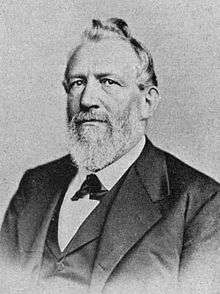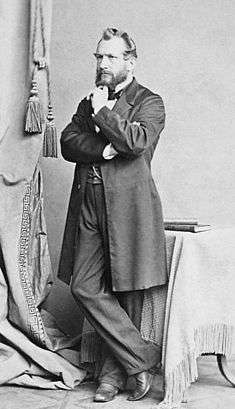Emil du Bois-Reymond
| Emil du Bois-Reymond | |
|---|---|
 | |
| Born |
7 November 1818 Berlin, Germany |
| Died |
26 December 1896 (aged 78) Berlin, Germany |
| Nationality | German |
| Fields |
Physiology Electrophysiology |
| Known for | Nerve action potential |
| Influenced | Eduard Hitzig |
Emil du Bois-Reymond (7 November 1818 – 26 December 1896) was a German physician and physiologist, the discoverer of nerve action potential, and the developer of experimental electrophysiology.
Life
Du Bois-Reymond was born in Berlin, and spent his working life there. One of his younger brothers was the mathematician Paul du Bois-Reymond (1831–1889). The family was of Huguenot origin.
Educated first at the French College in Berlin, then at Neuchâtel, where his father had returned, du Bois-Reymond became a student of the University of Berlin during 1836. He seems to have been uncertain at first as to the topic of his studies, for he was a student of the renowned ecclesiastical historian August Neander, and dallied with geology, but eventually began to study medicine with such zeal and success as to attract the notice of Johannes Peter Müller (1801–1858), a well-known professor of anatomy and physiology.
Müller's earlier studies had been distinctly physiological, but his preferences caused him later to study comparative anatomy. He had, about the time when the young du Bois-Reymond came to his lectures, published his Elements of Physiology, in which the statement following occurs:
"Though there appears to be something in the phenomena of living beings which cannot be explained by ordinary mechanical, physical or chemical laws, much may be so explained, and we may without fear push these explanations as far as we can, so long as we keep to the solid ground of observation and experiment."
During 1840 Müller made du Bois-Reymond his assistant for physiology, and as the beginning for an inquiry gave him a copy of the essay which the Italian Carlo Matteucci had just published on the electric phenomena of animals. This determined the work of du Bois-Reymond's life. He chose as the subject of his graduation thesis "Electric fishes," and so commenced a long series of investigations on bioelectricity. The results of these inquiries were made known partly in papers communicated to scientific journals, but also and chiefly by his work Investigations of Animal Electricity, the first part of which was published during 1848, the last during 1884.
Concerning his religious opinions, du Bois-Reymond was an atheist.[1]
Works

Du Bois-Reymond developed the idea that a living tissue, such as muscle, might be regarded as composed of a number of "electric molecules," and that the electric behavior of the muscle was the outcome of the behavior of these native electric molecules. We now know that these are sodium, potassium and other ions, the gradients of which are responsible for maintaining membrane potentials in excitable cells.
His theory was soon criticized by several contemporary physiologists, such as Ludimar Hermann, who maintained that a living untouched tissue, such as a muscle, is not the subject of electric currents so long as it is at rest, it is isoelectric in substance, and therefore need not be supposed to be composed of electric molecules, all the electric phenomena which it manifests being due to internal molecular changes associated with activity or injury. Du Bois-Reymond's theory was of great value if only as a working hypothesis, and that as such it greatly helped in the advance of science. Thus, du Bois-Reymond's work concerned mainly animal electricity, yet he made other physiological inquiries — such as could be studied by physical methods —- especially concerning the phenomena of diffusion, though he published little or nothing concerning his results.
For many years, du Bois-Reymond exerted a great influence as a teacher. During 1858, upon the death of Johannes Müller, the professorship of anatomy and physiology, which that man had possessed, was divided into a professorship of human and comparative anatomy, which was given to Karl Bogislaus Reichert (1811–1883), and a professorship of physiology, which was given to du Bois-Reymond. This he had until his death, performing his research for many years though at first without adequate accommodation. During 1877, by his influence, the government provided the university with a proper physiological laboratory. During 1851 he was admitted to the Academy of Sciences of Berlin, and during 1876 became its perpetual secretary.
For many years du Bois-Reymond and his friend Hermann von Helmholtz, who like him had been a pupil of Johannes Peter Müller, were well-known scientists and professors in Berlin. Acceptable at court, they both used their influence for the advancement of science. Du Bois-Reymond, as has been said, had during his earlier years studied topics other than those of physiology and medicine, and during his later years he reviewed some of these. His gave occasional discourses, dealing with general topics and various problems of philosophy.
The Seven World Riddles
During 1880 du Bois-Reymond made a well-known speech before the Berlin Academy of Sciences defining seven "world riddles" some of which, he declared, neither science nor philosophy could ever explain;[2] he considered them "transcendent". These "riddles" are as follows:
- the ultimate nature of matter and force,
- the origin of motion,
- the origin of life,
- the "apparently teleological arrangements of nature," not an "absolutely transcendent riddle,"
- the origin of simple sensations, "a quite transcendent" question,
- the origin of intelligent thought and language, which might be known if the origin of sensations could be known, and
- the question of free will.[3]
Concerning numbers 1, 2 and 5 he proclaimed: "ignoramus et ignorabimus": "we do not know and will not know."
References
- ↑ Meulders, Michel (2010). "5: Helmholtz and the Understanding of Nature". In Laurence Garey. Helmholtz: From Enlightenment to Neuroscience. MIT Press. p. 74. ISBN 9780262014489.
Du Bois-Reymond was a self-proclaimed atheist but more through intimate conviction than logical necessity.
- ↑ Finkelstein, Gabriel Ward (2013). Emil du Bois-Reymond: Neuroscience, Self, and Society in Nineteenth-Century Germany. Cambridge, Massachusetts: The MIT Press. p. 272. ISBN 9780262019507.
- ↑ Leverette Jr., William E. (1965). "E. L. Youmans' Crusade for Scientific Autonomy and Respectability". American Quarterly. 17 (1): 21. JSTOR 2711334. doi:10.2307/2711334.
Sources
 This article incorporates text from a publication now in the public domain: Chisholm, Hugh, ed. (1911). "Du Bois-Reymond, Emil". Encyclopædia Britannica (11th ed.). Cambridge University Press.
This article incorporates text from a publication now in the public domain: Chisholm, Hugh, ed. (1911). "Du Bois-Reymond, Emil". Encyclopædia Britannica (11th ed.). Cambridge University Press.
- Pearce, J M (November 2001). "Emil Heinrich Du Bois-Reymond (1818–96)". J. Neurol. Neurosurg. Psychiatr. 71 (5): 620. PMC 1737619
 . PMID 11606673. doi:10.1136/jnnp.71.5.620.
. PMID 11606673. doi:10.1136/jnnp.71.5.620. - Dierig, S (April 2000). "Urbanization, place of experiment and how the electric fish was caught by Emil du Bois-Reymond". Journal of the history of the neurosciences. 9 (1): 5–13. PMID 11232350. doi:10.1076/0964-704X(200004)9:1;1-2;FT005.
- Gradmann, C (2000). "[History as natural science: Ernst Hallier and Emil du Bois-Reymond as cultural historians]". Medizinhistorisches Journal. 35 (1): 31–54. PMID 10829580.
- Meltzer, SJ (February 1897). "EMIL DU BOIS-REYMOND". Science. 5 (110): 217–219. PMID 17829443. doi:10.1126/science.5.110.217.
- Loos, H (August 1985). "[The relation between physiology and medicine in Emil du Bois-Reymond]". Zeitschrift für die gesamte Hygiene und ihre Grenzgebiete. 31 (8): 484–5. PMID 3904238.
- Geddes, L A (1999). "From muscle twitches to sustained (tetanic) contraction: the discovery of du Bois-Reymond". IEEE engineering in medicine and biology magazine: the quarterly magazine of the Engineering in Medicine & Biology Society. 18 (1): 85–6. PMID 9934607.
External links
 Media related to Emil DuBois-Reymond at Wikimedia Commons
Media related to Emil DuBois-Reymond at Wikimedia Commons Works written by or about Emil du Bois-Reymond at Wikisource
Works written by or about Emil du Bois-Reymond at Wikisource- Short biography, bibliography, and links on digitized sources in the Virtual Laboratory of the Max Planck Institute for the History of Science